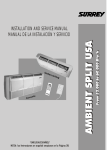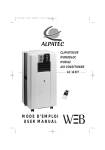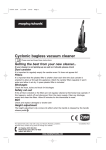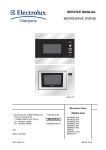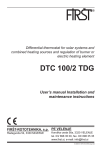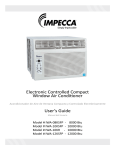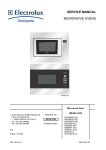Download Benefon TWIG CONFIGURATOR Operating instructions
Transcript
TWIG PROTECTOR PRO Quick Guide TWIG Protector Pro protection device is designed to be your personal "guardian angel" – intended for all areas of personal and professional safety. Instructed by simple icons, the device is especially suitable for children and elderly people as well as for applications or situations where simplicity and robustness is a must Please refer to Your Service Provider for full details on how TWIG device operates with Your Service. Manufacturer: Twig Com Ltd Lairolantie 14, 24910 HALIKKO, FINLAND web: www.twigcom.com INSERTING THE SIM CARD 1. Slide the micro-SIM card to the holder from the hole on the side of the unit contacts in the SIM are facing towards keypad and the cut corner of the card inward. Make sure the card locks to holder. Do not use force, as the SIM will go to its place easily. 2. Push the SIM card all the way in with e.g. another SIM card or some small stick. Do not use sharp or metal tools or objects! 3. Insert the rubber plug to the SIM holder hole. The device is dust and water proof according to IP67. To meet the requirements, the rubber plug must be inserted in place correctly. If the plug is damaged it must be changed immediately to maintain tightness and warranty. INITIALIZING THE DEVICE Publication number: YZ3500-01 All rights reserved. © Twig Com Ltd. Twig Com Ltd. declares that this mobile device, type TUP90EU, is in compliance with the essential requirements and other relevant provisions of Directive 1999/5/. Information in this Quick Guide is subject to change without notice. Twig Com Ltd. reserves the right to change or improve their products and to make changes in the content without obligation to notify any person or organization of such changes or improvements. Twig Com Ltd. is not responsible for any loss of data, income or any consequential damage whatsoever caused. Some of the features described in this guide are optional and intended to be purchased separately. For more information, please contact your dealer. *Instructions are only guidelines. Please consult your system provider for detailed instructions. For more information, details and descriptions, including device configuration and assortment of chargers and accessories, visit the web site: www.twigcom.com. WHAT TO DO FIRST DOWNLOAD CONFIGURATION SOFTWARE, INSTRUCTIONS AND DRIVERS FROM www.twigcom.com/ If possible turn off the PIN request from the SIM card. If not, change the PIN code to 9999 or change the PIN code that is programmed to Protector to same that is used in SIM card before starting the phone. Changing the PIN code that unit automatically uses, please refer to configuration guide and PC Configure program. When you start using the device for the first time, you should charge the battery first. Please note that the battery will reach its full capacity only after two or three charging times. POWER SUPPLY -Mains charger with the charger adapter or charging cradle -Li-Ion polymer battery is integrated into the unit. The battery type and capacity may vary depending on the market area and model of the unit in the sales package. battery above or below these temperatures the life of a battery may be shortened. Also, the battery may not reach full capacity. Battery charging is not allowed below +0°C or above +50°C When charging the battery, about 70% of the battery capacity will be charged quickly, the remaining 30% takes relatively more time. Also note that humidity, temperature, age of the battery and currently used features (e.g. the GPS) affect the charging time. BATTERY CARE, MAINTENANCE AND DISPOSAL The continuous operating time is less when using an old battery than a new battery. When storing unit for a long time, it should be kept cool and with fully charged battery in a dry place. Li-Ion batteries do not contain heavy metals which can damage the environment. Batteries should be disposed of according to the country-specific regulations. ENVIRONMENTAL EFFECTS IN USAGE SIGHT The device must have an unobstructed view to satellites at any time. In marginal conditions (e.g. when staying in surroundings with heavy tree cover or in a shadow area in between base stations) GPS positioning may not work properly. The device can be used like a standard GSM phone with the limited feature set. In some cases, the device can be built in clothes or special vests. If the device is mounted somehow, it must be attached to the surface so that the back of the device is facing up and the top of the phone upwards to ensure proper functioning of the GPS and GSM. The unit can be covered with thin low loss material such as plastic, fibre glass or clothes, but not with metal. This is regarding particularly to GSM and GPS antenna areas! TEMPERATURE RANGES MAINS CHARGER The mains charger should only be used indoors. Make sure that the voltage in the country which you are staying corresponds to the voltage marked on the charger. When charging, connect the mini USB connector to mini USB connector in charging adapter or the charging cradle. Twist the Charging adapter to the bottom of the phone from keyboard side down, all the way until it clicks on its place on back cover. If placing to charging cradle, place first the bottom towards the charging pins in the cradle and the let the top of the unit lie down. CHARGING The device controls the charging status, the battery temperature and power supply during the charging operation. The ideal temperature range for charging is +10°...+30°C. If charging the -Usage: -20°C to +55°C, at temperatures below -20°C, or above +55°C, the battery will not supply power and the device will shut down to prevent damage. Upon warming up/cooling down, the device will function properly again -Charging: Battery must not be charged below °0. Likewise, charging above +50 °C is prevented. . USER INTERFACE GSM/GPRS NETWORK STATUS GSM is on STRAP HOLE GPRS is used for telematics EARPHONE GPRS is active for telematics GSM is roaming . Phone is using other than home network. Call and position transmissions are charged according to roaming agreements. Position transmissions may have been blocked automatically. Bars on top of the network status icon indicate the strength of the GSM network. The more bars the better the GSM network. - Four bars - high network strength - No bars - no network DISPLAY -GSM status -GPS status -Battery status -Indicator icons KEYS TWIG SOS BUTTON -Emergency calls -Emergency reports GENERAL STATUS ICONS TWIG SOS /TWIG SOS call is active. / SEND KEY TWIG SOS in is post emergency mode. Position requests are possible from emergency numbers Tracking is active to one or more destinations -Answer calls END KEY -Rejecting/end calls -Cancel some operations -Power on/off No metal sticker here NUMBER KEYS / -Information call/sending position -Amber Alert functions -Man Down control Man Down Alert is active / failed. Automated emergency cycles are possible Wireless Alert ( wrist alert) connection available / failed Amber Alert / Condition Check is activated. Automated emergency cycles are possible GPS POSITIONING STATUS GPS is active MICROPHONE LOUDSPEAKER (not in all models) GPS is sleeping GPS is not available Bars on top of the network status icon indicate the accuracy of the last GPS position. The more bars and the taller the bars, the better the accuracy. If the position is older than 1 – minute the signal bars are shown as wire frames SIM HOLDER SYSTEM CONNECTOR -connecting charger or data cable to the device. DISPLAY/TONE NOTIFICATIONS DISPLAY INDICATORS DEVICE IN STAND-BY MODE GSM BATTERY NETWORK INDICATOR INDICATORS / TELEMATICS FEATURES INDICATORS GPS POSITIONING INDICATORS NETWORK OPERATOR/SERVICE PROVIDER IDENTIFIER BATTERY STATUS The level indicates charge left in the battery. / During charging, the battery icon is changed to indicate this event. GENERAL NOTIFICATIONS Processing. An operation is in progress, please wait. General failure. Shown when an operation fails. E.g. if you try to make a call when there is no number pre-configured in the device. Simultaneously, the Failure tone is played. SIM failure. Shown when there is no SIM card inserted in the device, or if the PIN code was rejected. Simultaneously, the Failure tone is played. CHARGING NOTIFICATIONS Battery low. Shown when there is a need to recharge the battery. Simultaneously, the Battery low tone is played. The device is connected to a charger. Settings during battery loading take place. Simultaneously, the Charging tone is played. The device is disconnected from a charger. Settings during battery loading are ended, the device returns to normal operation. NOTIFICATIONS REFERRING CALLS OR MESSAGES Normal incoming call. If available, the name associated with the calling number/the phone number itself is shown on the bottom. Shown until the call is answered (to answer, press SEND KEY). Initiating information call or position report. Press the corresponding number key and hold it down while this notification is shown. Sending a position report. Simultaneously, the Message sending tone is played. Making an information call. Shown until the call is answered. A call is in progress. Shown while the call is connected. START EMERGENCY CYCLE NOTIFICATIONS (DISPLAYS ON) Starting emergency cycle (a long press): Emergency tone settings are switched on. Press the TWIG SOS button and hold it down until the wedges are all turned black. Starting emergency cycle (two quick presses): Press the TWIG SOS button briefly. Emergency tone settings are switched on. Press the button again when the second circle starts blinking. Emergency cycle cancellation period. A countdown timer is shown on the bottom. The timer counts the cancellation time left (in seconds). Simultaneously, the Cancellation tone is played. To cancel the emergency cycle, do it while this notification is shown (by pressing the END KEY). OTHER EMERGENCY CYCLE NOTIFICATIONS (DISPLAYS ON) Emergency cancellation. Shown right after the emergency cycle was cancelled. Emergency completion. Shown when the emergency cycle ends normally, or when the emergency mode is ended manually. Emergency call retry. Emergency numbers can be voice call numbers. The notification is shown when the device makes another call attempt to a number. Emergency mode/Working. The device is through with emergency calls, but sending messages, message confirmation or position refresh is still going on. Emergency confirmation message received. After receiving confirmation, the device will end resending of an emergency message. Simultaneously, the Message reception tone is played. "Post-emergency mode". The GSM operator´s name is replaced by the emergency symbol. While this notification is shown, the device can be tracked by emergency numbers, also emergency tone and display settings are kept on. This mode can be terminated manually, by pressing the END key. NETWORK EMERGENCY CALL (112, 911, 000, 999, 08 etc) Network emergency call query. Shown when the TWIG SOS button is pressed but making emergency cycle is NOT possible (e.g. SIM card is missing or no roaming network available). You may still try to make network emergency call by pressing SEND KEY. You can also exit the query without making an emergency call by pressing END KEY DISCREET EMERGENCY CYCLE (DISPLAY NOTIFICATIONS OFF) During the discreet emergency cycle, the device looks like it is in stand-by mode. The only indicator of the ongoing emergency cycle is the Emergency cycle indicator appearing to icon area. When the icon disappears / changes the cycle is over or moved to post emergency mode. Also tones can be turned off. NOTIFICATIONS REFERRING SENSOR ALERTS Pre-alarm for sensor alert is NOT set. Shown when "the cancel timer" is not configured, and Emergency cycle starts right away. To mute the audible alert tone, press the END key Pre-alarm for sensor alert is set. The countdown timer shows that you still have 27 seconds time left to cancel the sensor alert if you so desire. To cancel the emergency cycle, lift the device to vertical position. Do it while this notification is shown. To let the emergency cycle take place: Do nothing. To mute the audible alert tone, press the number 1 key Alert state ended. Shown right after the emergency cycle is finished, or the sensor alert is cancelled. Post-alarm state. Shown when the emergency cycle is completed, and the device makes audible alarms at regular intervals. You can receive phone calls and answer them by pressing SEND. In order to stop the post-alarm tone press END key. NOTIFICATIONS REFERRING AMBER ALERT / COND CHECK Keep pressing to activate Amber Alert / Condition check 10 Timer value. Adjust with keya 1 and 2 in 10 minute increments. Press 1 to cancel Amber Alert / Condition check mode. Press 2 to ignore. BASIC KEY FUNCTIONS TURNING THE DEVICE ON 1. Press END KEY and hold it down for a few seconds. 2. The logo is shown. TURNING THE DEVICE OFF 1. Press the END KEY and hold it down for a few seconds. 2. The logo is shown and the Power down tone is heard. ADJUSTING VOLUME DURING A CALL Press the 1 and 2 keys during call, 1 to lower and 2 to rise the volume . ANSWERING INCOMING CALLS Press the SEND KEY key when the device alerts. NOTE: The device may be configured to answer some/all incoming calls automatically. It may even be, that all incoming calls are bloked and you can not receive calls. DROPPING/ENDING/CANCELLING A CALL Press the END KEY briefly. MAKING AN INFORMATION CALL Press the corresponding number key and hold it down for a few seconds. The device will call to configured number. messages: Press the END KEY and hold it down for several seconds. After successful cancellation the device will return to normal operation and switch back to normal tone and display settings. ENDING EMERGENCY MODE MANUALLY The emergency mode must be terminated manually. This means, the emergency tone settings are kept on and the emergency numbers are permitted to track the device without further notice. Emergency tones and tracking option are switched on from the moment you start the emergency cycle (by pressing the TWIG SOS button) until you end the emergency mode (by pressing the END KEY briefly). Another alarm cycle is not possible before previous is ended. SOME CIRCUMSTANCES MAY AFFECT ON EMERGENCY CYCLE AND MODE •Being in a shadow area of the GSM network at the time of the event. •Poor GPS coverage during emergency cycle may cause the emergency cycle completion to slow down. •Busy telephone lines when connecting (voice) calls. •Message transmission errors caused by the carrier of an SMS/GPRS, i.e. the network operator. SENSOR ALERTS To cancel sensor alert and prevent emergency cycle from starting, change the phone to allowed position (horizontal or vertical) or move it gently if it is configured to detect only movement. Do it while the countdown timer is still shown. To let the emergency cycle take place: Do nothing. To mute the audible alert tone, press the 1 key SENDING POSITION REPORT INCOMING/OUTGOING MPTP MESSAGES 1. Press the corresponding number key and hold it down for a few seconds. 2. After sending the position report, the device may receive an incoming information call - depending on service. 3. When the device starts alerting, answer the call by pressing the SEND KEY. NOTE: The device may also be configured to answer the call automatically. AMBER ALERT /CONDITION CHECK MAKING EMERGENCY CALLS AND SENDING EMERGENCY MESSAGES (EMERGENCY CYCLE) Press the TWIG SOS button according to configuration (a long press/ two quick presses). The device will make emergency calls and send emergency reports (emergency messages including position information) according to configuration. CANCELLING EMERGENCY CYCLE During cancellation period you may hear the cancellation tone and see timer showing time left for cancellation. •To cancel the entire emergency cycle, press the END KEY briefly during the cancellation period. •When the emergency cycle has already started you may, depending on configuration still cancel the rest of the calls and The device may send or receive some MPTP messages. In most cases messages are either remote configuration/activation messages, some notifications, emergency reports or various types of position messages and they work autonomously according to configuration. •In most cases there are no display notifications. •Message sending/reception tones are configurable (beep sound as a default). 1. Press the activation key ( number 3) and hold it down for a few seconds. 2. Device will prompt default timer value. Value can be adjusted with keys 1 and 2. 3. Press number 3 again to confirm and activate timer. If the function is in local mode it will start immediately but if the mode is interactive it requires acknowledgement from control centre. Once the timer pre-alarm time expires, user must acknowledge and reset the timer. Failure will activate the Emergency Cycle. MAN DOWN ALERT CONTROL Toggle Man Down function ON/OFF with button 4 if allowed by Your Service Provider. CARE AND MAINTENANCE NOTE: The instructions below apply to the device, its accessories, batteries in use as well as batteries taken out of use. Dust and dirt may damage the moving parts of the device. Do not use or keep the device in dusty or dirty surroundings. -Do not open the device or battery by yourself or pierce holes in it. -Rough handling may break the circuitry inside the device. Do not drop, knock, twist or shake the device or its battery. -Keep the device dry. Liquids contain minerals which could corrode electronic circuits. If the device gets wet, turn it off and dry the device and the battery immediately. Put the device into an upright position and let it dry. It is recommended that a dealer or service personnel check that the device functions properly. -Even the device is waterproof, do not wet the device unnecessarily or immerse it in water. -Protect the device from heat. High temperatures may shorten the life of the electrical devices, melt or warp plastics and damage batteries. -Do not warm up the device or battery or use it near fire. -Do not short-circuit the battery or battery contacts. Exposing the metal strips of the battery to a close contact with a metallic object, such as a coin, a clip or a set of keys can cause accidental short-circuiting and damage the battery. -Charge and recharge the battery only with the charger specified in the Operating instructions/Quick Guide. -Clean the device with a soft cloth, dampened slightly with mild soapy water. Do not clean the device with harsh chemicals, solvents or other corrosive substances. -Only allow authorised service personnel to service the device. SAFETY AND PRECAUTIONS TELEMATICS PROTOCOL MPTP (Mobile Phone Telematic Protocol) allows, among other things, tracking of the device over the SMS/GPRS communication. Automatically sent telematics messages are only allowed to authorised numbers configured in the device. Such numbers can be, e.g. emergency and service center numbers. Position of the device is retrieved by the GPS, or by the network parameters -the latter being a network-dependent service. The carrier for telematics messages is an SMS-message or GPRS data. Deliveries of all messages is fully handled by and in the responsibility of the GSM network operator and services can vary substantially. The charge of a protocol message is determined on the contract by the service provider. GPS The Global Positioning System (GPS) is operated by the government of the United States, which is solely responsible for its accuracy and maintenance. The system is subject to changes that could affect the accuracy and performance of all GPS equipment. EMERGENCY CALLS The device is an aid and should never be relied upon as an emergency device. Its functionality is dependent on GSM network and GPS satellites which may not be available all the time. To make emergency calls, the device must be turned on and located in an area with adequate GSM network signal strength. Making TWIG SOS emergency call also requires GPS satellite coverage and a valid SIM-card. Emergency calls may not be possible on all GSM phone networks or when certain network services or phone features are in use. In unclear cases, consult the network operator. GENERAL Traffic: Strictly adhere to all eventual European and national legislation and also honour other eventual safety recommendations when using the device while driving a vehicle. Place the device in its holder, do not leave it on the passenger seat or some other place where it can break loose in a collision or a sudden stop. When receiving a call in an awkward driving situation, you must always put safety before other priorities and courtesy. If you feel uncomfortable about using a device while driving, you should not use it. Vehicles with air bags: An air bag inflates with great force. Do not place objects, including either installed or portable wireless devices, in the area over the air bag or in the air bag deployment area. External alert: The use of the alert device to operate a vehicle´s lights or horn on public roads is not permitted. Children: Keep the device and its accessories away from small children to avoid causing injury to themselves or others. Damage to the device or its accessories is also thus avoided. Power supply: This equipment is intended for use with the specified power supplies listed in the Quick Guide/Operating Instructions. Any other usage will invalidate any approval given to this apparatus and may be dangerous. Other accessories: Any other accessories used should also be approved by the device manufacturer. Check the compatibility of new power supply units and other accessories at the dealer or manufacturer. Connections: All installations, connections and service regarding the device, its power supply and accessories should be approved by the device manufacturer. Use of any unauthorized accessories, modifications or attachments may be dangerous and voids the device warranty if said accessories cause damage or a defect to the device. Magnetic fields: The device contains small magnetic components. Even though the magnetic fields of the components are weak, they might damage magnetic cards, such as bank and credit cards. We recommend that you would keep the device away from magnetic cards. Storing positions: Position information is stored correctly in the device when the GPS is turned off or powered off. To prevent the memory from becoming corrupted, never power off the device by removing the battery. Neodymium magnets: Some models include strong magnets. Magnets could effect the functioning of pacemakers and implanted heart defibrillators. If you wear these devices keep sufficient distance to magnets. Warn others who wear these devices from getting close to magnets. Keep magnets away from devices and objects that could be damaged by magnetic fields. RADIO FREQUENCY (RF) ENERGY Aircrafts: Turn your device off before boarding any aircraft and do not use the device while in the air. Besides being illegal, the use of a device in an aircraft may endanger the operation of the aircraft or disrupt the mobile network. Failure to comply with this instruction may lead to suspension or denial of mobile phone services, and possibly even legal action. Hospitals: Turn your device off before entering hospitals or other health care facilities where medical electronic equipment may be in use. Such devices can be extremely sensitive to radio frequency interference. Only use the device with permission and under the instruction of hospital staff. Medical devices: Remember that any personal medical devices (such as hearing aids or pacemakers) may be affected by RF energy if they are not adequately shielded. Consult the manufacturer or vendor of the equipment to determine the proper shielding. Posted facilities and country-specific regulations: Power off the device in any facility where posted notices require to turn off mobile phones. Also follow all the country-specific regulations applicable to where the device is used. Potentially explosive atmospheres: Turn off the device at refuelling points, e.g. gas stations. Also observe restrictions on the use of radio equipment in fuel depots, chemical plants or where blasting operations are in progress because remote control RF devices are often used to set off explosives. Do not store or carry flammable liquids, gases or explosive materials in the same compartment as the device, its parts or accessories. Other electronical equipment: Using the device may cause interference with a vehicle's electronic equipment if it is not adequately shielded. Consult the manufacturer or the vehicle seller to determine the proper shielding. Computers: Remember that using the device close to a computer may cause interference. When using your device near such equipment keep a distance of about one meter. Body parts: When the device is in operation do not touch the antenna with eyes, mouth or bare skin to guarantee proper function. WARRANTY Twig Com Ltd. warrants to the original purchaser (“Company”) that this Twig Com device and all accessories originally provided by Twig Com in the sales package (“Product”) are free from defects in materials, design and workmanship under normal use in accordance with the operating instructions and pursuant to the following terms and conditions. Warranty periods are determined with the purchase agreement Individual warranty terms and conditions are available from Twig Com or from local distributor. The warranty is void if the unit is opened or the warranty seal on the screws are tampered





